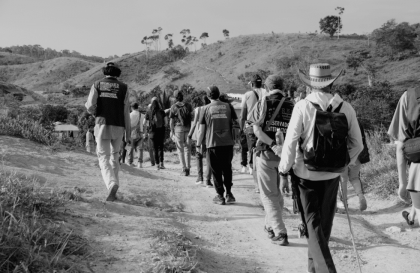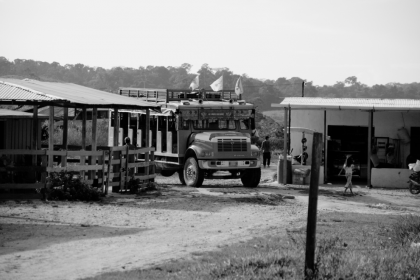One year after Gustavo Petro became president of Colombia, paramilitarism continues to challenge the authority of the state and represents one of the most serious threats to the Total Peace project that the Colombian president has made one of the main focuses of his government. Among the regions most affected by this problem is the Northeast of Antioquia, in the department of Antioquia, a strategic region due to its gold mining resources and its strategic geographic position. The Autodefensas Gaitanistas de Colombia (AGC), also known as Clan del Golfo, have been present in the region for approximately two years and four months ago made incursions into the Monte Frío Alto, Las Jaguas, Las Palmas and Arenales areas, causing the forced displacement of the inhabitants of these villages.
The entry of this paramilitary group into the region gave rise to armed clashes with the National Liberation Army (ELN) insurgency, which has a historic presence in the region. On 29 and 30 June, in the village of Arenales, which belongs to the municipality of Segovia, the two groups clashed from opposite sides, with the population of the village confined to the middle. Although there were no deaths at the time, more than 300 villagers were displaced to the village of Rancho Quemado, where they set up a humanitarian refuge that is still in precarious conditions. On 24 July, the head of this refuge was shot six times in an attack that has gone unpunished, and the seriousness of which has prompted many of the displaced to flee again in search of places offering better guarantees, such as the departmental capital, Medellín.

The alerts generated by these serious events led different organizations such as the Corporación Comité de Derechos Humanos Jesús María Valle Jaramillo, the Región de los Dos Ríos, the Congreso de los Pueblos and the Coordinador Nacional Agrario to call for a humanitarian caravan that took place in the north-east of Antioquia from 31 July to 2 August, with the international accompaniment of the Red de Hermandad y Solidaridad con Colombia (Redher).
To get to Rancho Quemado, you have to leave the municipality of Segovia, which is dedicated to the exploitation of the gold that is extracted throughout the area, and take a long drive along unpaved roads that are difficult to navigate. As soon as one leaves the urban zone and enters the rural area, the presence of the AGC is immediately noticeable by the graffiti with which this group makes it known that it dominates the territory. Although the authorities claimed after these incidents that the army was controlling the roads, we only saw one small patrol in the vicinity of Segovia, preceded by men in civilian clothes who were apparently acting as AGC guards. The fact that we were accompanied by an official from the Victims' Unit and that the organization of the caravan was publicly known was probably the reason why we did not encounter a greater presence of the AGC along the route.
During the journey, the landscape appears to be a mixture of extensive cattle farming and mining operations. In the area of the river that flows parallel to the road, numerous backhoes can be seen dredging the riverbed in search of gold, a practice that is extremely harmful to the environment. After several hours of driving, we pass the ELN-controlled area, which can be seen from the ELN's graffiti. Finally, we arrived at Rancho Quemado, where for two days we received testimonies of the state's abandonment of both the displaced people of Arenales and the residents of this village. The testimonies refer to the lack of guarantees for life in a region where the state is conspicuous by its absence, the villagers are responsible for building infrastructure such as roads and schools, there are no medical services or emergency care, and the lack of water is another serious problem. But the most pressing problem at the moment is the security problem arising from the internal conflict. In addition to the risks of the recent fighting, the paramilitaries have subjected this area to an intense blockade: "We are threatened, they tell us that we have to stop our economic activity from which we live. If we can't carry out artisanal mining or our daily activities, what are we going to live on? Since a month and a half ago, when the AGC blocked the passage of fuel to the Northeast region, the entire economy of the region has been damaged, preventing the normal development of mining, commercial or agricultural activities. The AGC blockade began with their entry from the urban centre of Segovia and also through the alternative road of Puerto López.
On Monday July 3rd, the AGC entered the village of Arenales, scratched the walls with their acronyms and slogans, announcing that they were coming to remove the guerrillas and take control of the area. The strong accusations against neighbours of supposedly belonging to the insurgency forced many to leave the region. Finally, the trigger for the massive displacement was the direct confrontations between ELN and AGC that included the use of explosives, some of which did not explode and represent a potential risk. These confrontations caused the communities to be initially confined to the village of Racho Quemado, where a humanitarian refuge was declared with people from Arenales, Las Jaguas and other villages, reaching approximately 329 people in a scenario of food shortages, drinking water, health, housing, limited work and state ineffectiveness. The subsequent murder on 24 July of Carlos Mario Roldán, leader of the Rancho Quemado humanitarian shelter and neighbour of Arenales, demonstrated the serious risk faced by the region's inhabitants.
Local organizations have denounced the permissiveness of the security forces with the AGC, since when this group is present, the security forces are also present; what has been seen is that the army only confronts the insurgencies and the AGC take over the places where the army passes through.
In the report issued after the caravan was held, the convening organizations stated: "The collusion between the public forces and the paramilitary groups is evident, since from the entrance to the urban centre to the entrance to the Matuna huerta, less than 500 metres away, the AGC are making checkpoints, registering the communities and sometimes robbing the peasants". The other major threat they highlight is the fear that if the paramilitaries consolidate territorial control, they will plant coca crops, which are not currently grown in this area: "we don't want to go to the extreme that if they take over the territory they will come with the ideals of planting coca, and it is no secret that where there is coca there is terror".

In the face of this situation, the Government of Antioquia has ignored the serious situation of vulnerability in which the families have found themselves since the fighting, without declaring a humanitarian emergency in the region and generating a revictimisation by not attending to the families who are still in the humanitarian shelter.
The end of the caravan coincided with the establishment the following day of the bilateral ceasefire between the Colombian government and the ELN. The UN Security Council decided on 2 August to extend the mandate of the Verification Mission in Colombia to include the monitoring and verification of the implementation of the ceasefire established in the Second Cuba Agreement between the Colombian government and the ELN. For his part, the spokesperson for the UN Secretary-General congratulated the Government of Colombia and the National Liberation Army (ELN) for initiating a new stage in their peace process on the occasion of the entry into force of the bilateral ceasefire agreement.
In Bogotá on August 3rd, the announcement of a ceasefire and the establishment of a political participation table, all part of the peace process between the state and the guerrillas, were presented to a packed audience of delegations from all over the country. The importance of paramilitarism as one of the major risks to the peace process was made clear in the intervention of the head of the ELN negotiating delegation, Pablo Beltrán, who stressed that, in addition to the robust verification mechanism of the ceasefire, it relies mainly on the willingness of the two parties to comply with it: "we are trying to ensure that during the first six months there is a cessation of offensive operations, leaving only defensive operations, unfortunately Colombia has a very serious situation, where not only guerrilla, military and police forces are operating, but there are also gangs, groups and many paramilitary groups, who are currently doing the most damage to communities and social leadership". Beltrán pointed out that although the assassinations of social leaders and massacres have not decreased with this government, the responsibility comes from a regime that has made this a habit: "the problem is that there are more forces outside the government that do persecute and exterminate, there is a new government, but the old regime is alive, the essence of the old regime is to persecute and exterminate, and this has to end".
For Petro's government, the process with the ELN, although it may be the most ambitious of those that make up its Total Peace proposal, is not the only one, and it also maintains other processes open with FARC dissidents, with criminal groups in Buenaventura and Medellín, and even with the Clan del Golfo, through the High Commissioner for Peace, who has held talks "with the objective of maintaining a minimum of relations and communication with this structure".
Meanwhile, in Rancho Quemado and Arenales, as in so many parts of Colombia, the conflict continues to rage and, although they are far from the spotlight of national and international attention, their inhabitants are demanding the adoption of measures to guarantee the life, physical integrity and permanence in the territory of these peasant and agro-mining communities, so that the government's current slogan "Colombia, World Power of Life" becomes a reality.